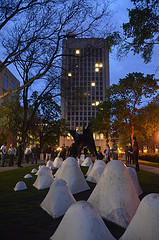Creating awe-inspiring, functional architecture and installation art from fabric is a contemporary phenomenon. It’s only within the last century that fabric has been chosen for large-scale structures such as bridges, domes, canopies, shelters, and buildings. Unlike materials like stone or wood, fabric is flexible and dynamic, adding an extra dimension to artistic creations. Artists and architects worldwide have opted to use fabric for its unique, expressive qualities.
- Colombia
In a bustling roundabout in Cúcuta, Colombia, a pedestrian bridge made of bamboo and fabric was installed in 2009. Possibly the largest bamboo and tensioned fabric structure ever constructed, the bridge has gained fame, even earning an Award for Excellence from the Industrial Fabrics Association International. A defining feature of Cúcuta’s urban landscape, the bridge is popular among the city’s residents.
- New Zealand
Artist Anish Kapoor creates art for both permanent and temporary installations. One of his many stunning permanent pieces is located at ‘The Farm’, an outdoor art gallery Appreciating Sculpture Art And What They're Made Of - Art can be expressed through various means, one of which is sculpture art. Ancient sculptures employed a range of materials, and this art form has been passed down through generations, continuing to be appreciated today. Statues, clay structures, and wood carvings are all examples of artistic expression. Many of these works are preserved and displayed… near Auckland, New Zealand. The vibrant red fabric sculpture spans 84 meters in length and weighs over 90,000 kilograms. It comprises two 25-meter steel ellipses, one oriented horizontally and the other vertically. These are connected and enveloped by a PVC-coated polyester fabric weighing 7,200 kilograms. A specialized cut was made in the hillside to accommodate the sculpture. When viewed through, the sculpture offers a kaleidoscopic perspective of the surrounding countryside.
- South Africa
The Nelson Mandela Bay Stadium in Port Elizabeth, South Africa, was constructed for the 2010 Sports World Cup. Known as the ‘Windy City’ due to its coastal location, Port Elizabeth’s fabric stadium was designed specifically to protect fans from local elements. It’s an elegant, open-air structure with translucent fabric sides, allowing natural light to permeate the interior space. The fabric used is Teflon, as it is easy to maintain and highly durable. 22,000 square meters of Teflon were employed.
- United States
The artwork ‘Surrounded Islands’ was created in 1983 by Christo and Jeanne-Claude, a married couple who design environmental art pieces. The islands encircled were in Biscayne Bay, near the coast of Florida. 603,850 square meters of pink polypropylene fabric were used to cover the shorelines of 11 islands. The fabric remained in place for two weeks, allowing the public to appreciate the art. Prior to encircling the islands, project workers spent approximately a year cleaning up trash from each landmass and its surrounding waters.
Manuel Marino is a seasoned Senior Producer, Music Composer, and Artist with over a decade of experience. He specializes in branded entertainment across various mediums, including video games, films, and advertising campaigns. With 20+ years as a game music composer, Manuel has worked on numerous platforms, creating diverse orchestral soundtracks. HIRE ME


 Manuel is a passionate, driven, and techsavvy AV technician,
Manuel is a passionate, driven, and techsavvy AV technician, 
